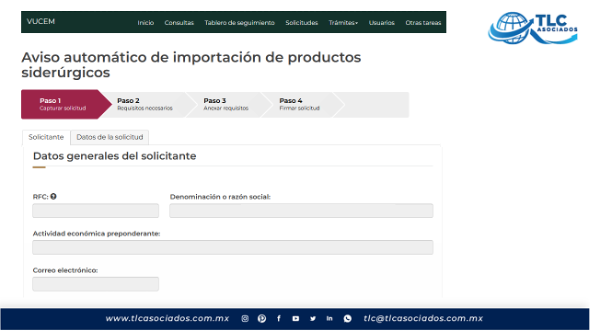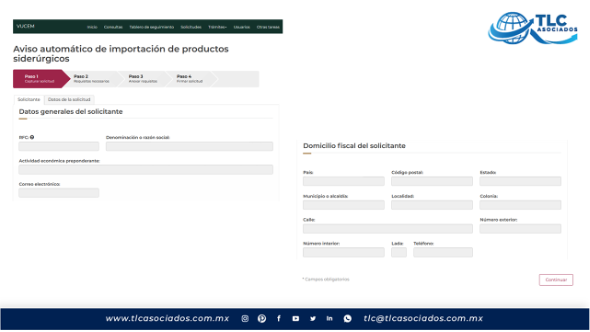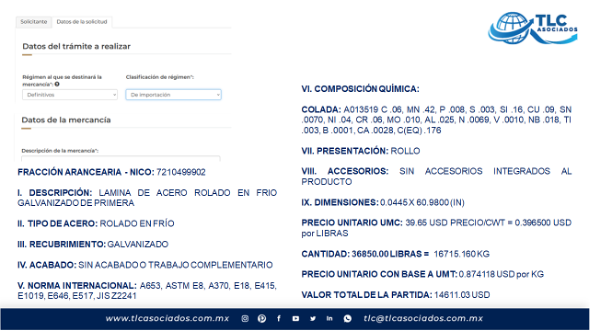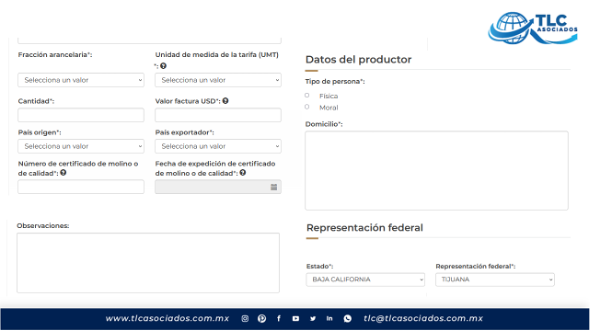
Debido cumplimiento en la gestión de los Avisos Automáticos de Importación de Siderúrgicos
I. AVISO AUTOMÁTICO
Las Reglas y Criterios de la Secretaría de Economía describen el “Aviso Automático” de forma similar que un “Permiso Automático”, al mencionar que se trata de un permiso automático a que se refiere el artículo 21 del Reglamento de la Ley de Comercio Exterior.[1]
En particular, este precepto jurídico menciona que la SE podrá sujetar la exportación o importación de mercancías al requisito de permiso automático, para efectos de llevar un registro de las operaciones de comercio exterior, siempre y cuando no exista otro procedimiento administrativo que permita la supervisión y seguimiento de dichas operaciones de manera más ágil.
II. CERTIFICADOS DE MOLINO Y CALIDAD
Derivado de recientes modificaciones a las Reglas y Criterios de la Secretaría de Economía fue simplificada la gestión de la solicitud del Aviso Automático de Importación de Productos Siderúrgicos (AAIPS), incluso considerar que la autoridad administrativa incorporo las facilidades del esquema alternativo establecidas en el numeral 10, último párrafo del Anexo 2.2.1 de las RCSE, por consiguiente, los importadores no tienen la obligación de adjuntar el “Certificado de molino o de calidad expedido por el productor o fabricante”.
El “Certificado de molino” se refiere al documento expedido por el Molino que acredita la empresa que produjo el acero, y el “Certificado de calidad” es el documento emitido y avalado por el fabricante de la mercancía a importar, los cuales se consideran que se encuentran avalados cuando estén firmados de manera autógrafa o contengan un código QR.
En esta tesitura, los documentos mencionados deberán contener la información que se indica a continuación:
a) Descripción detallada de las mercancías que ampara dicho certificado (incluyendo dimensiones, número de colada, especificaciones técnicas, físicas, químicas, metalúrgicas, etc.).
b) País de origen de las mercancías. En caso de que el certificado de molino o de calidad no especifique el país de origen de la mercancía a importar, se tendrá por cumplido este dato, siempre que contenga la ubicación de la empresa productora o fabricante.
c) Nombre y datos de contacto de la empresa productora o fabricante de las mercancías (dirección, teléfono y, en su caso, correo electrónico).
d) Número de certificado. En caso de que el certificado de molino o de calidad no contenga expresamente el número de certificado, se tendrá por cumplido este dato, siempre que contenga el número de colada, o el número de embarque, o el número de folio, o el número de orden.
e) Fecha de expedición.
f) Volumen de las mercancías.
g) Firma autógrafa o Código QR.
Cabe destacar, aun cuando las disposiciones actuales establecen la facilidad de no anexar los citados documentos en la gestión del AAIPS, es necesaria la información contenida en los certificados para obtener la clasificación arancelaria de las mercancías, así como para llenar las solicitudes de los AAIPS en la Ventanilla Digita, sin descartar que las autoridades podrá requerirlos.
III. GESTIÓN DEL AAIPS EN LA VENTANILLA DIGITAL
Las solicitudes de AAIPS que sean presentados a través de la Ventanilla Digital deben cumplir los puntos que se indican: [2]
| Campo | Comentarios |
| a) Fracción arancelaria | 8 dígitos relacionados con el numeral 8 del Anexo 2.2.1 de las RCSE. |
| b) Cantidad a importar (volumen) en unidad de medida de la Tarifa | Cantidad en UMT que corresponde a la clasificación arancelaria de la TIGIE. |
| c) Valor en dólares de la mercancía a importar sin incluir fletes ni seguros | En caso de que la compraventa se realice en cualquier otra divisa convertible o transferible, se debe convertir a dólares, conforme a la equivalencia de las monedas de diversos países con el dólar de los EUA, que publica mensualmente el Banco de México. |
| d) País de origen de la mercancía: | País en donde se fundió y coló el acero.
El país en donde se fundió y coló el acero se refiere a la ubicación original donde el acero crudo se produce primero en un horno de fabricación de acero en estado líquido y luego se vierte en su primera forma sólida. El primer estado sólido puede tomar la forma de un producto semiacabado (planchas, palanquillas o lingotes) o un producto de acería acabado. La ubicación de fundición y colado se identifica habitualmente en los certificados del molino que son comunes en la producción de acero, se generan en cada etapa del proceso de producción y se mantienen en el curso ordinario de los negocios. Este requisito de información no se aplicará a las fracciones arancelarias 72021101, 72021999 y 72023001 ni a las materias primas utilizadas en el proceso de fabricación de acero (es decir, chatarra de acero, mineral de hierro, arrabio, mineral de hierro reducido, procesado o peletizado, o aleaciones en bruto).” |
| e) País exportador hacia el territorio nacional. | País de procedencia. |
| f) Número de Certificado de molino y/o de calidad, deberá capturar: | S/N (sin número); |
| g) Fecha de expedición del Certificado de molino y/o de calidad: | Fecha de presentación de su solicitud; […] |
| h) Nombre y domicilio de la empresa productora. | |
| i) Descripción detallada de la mercancía a importar (en español), así como datos de la importación, conforme a lo siguiente: | i. Descripción del producto a importar, tal como tipo de acero, dimensiones, tipo de recubrimiento y acabado, en su caso accesorios integrados y clave de identificación del producto de acuerdo a las normas internacionales, como: ASTM, ASME, API, SAE, etc..
ii. Valor y precio unitario. iii. Aduana de entrada prevista. iv. Fecha en que se espera el envío desde el país de exportación. (Son únicamente referenciales y probables, por lo que, si son distintas, no implica que se altere la vigencia o invalida el documento)[3] v. Fecha esperada de importación. (Son únicamente referenciales y probables, por lo que, si son distintas, no implica que se altere la vigencia o invalida el documento)[4] |
| j) Derogado | Se elimina el campo de observaciones, que era utilizado cuando fuese necesario. |
Adicionalmente, debe tomarse en consideración que el valor y precio unitario contenidos en el permiso, deberá coincidir con la factura comercial que ampare la importación; caso contrario el permiso carecerá de validez.[5]
Cuando la factura y aviso automático emitido no contenga la misma unidad de medida, el aviso será válido, siempre que, al hacer la conversión, coincidan las cantidades, debiendo el importador declarar en el campo de “descripción de la mercancía” de la solicitud que se realice a través de la Ventanilla Digital, dicha circunstancia.
En aquellas solicitudes de avisos automáticos en las cuales no exista un campo para capturar el precio unitario, el importador deberá capturarlo en el campo de “Descripción de la mercancía”, a fin de que sea señalado en el aviso correspondiente.
Para efecto del cumplimiento con regulaciones y restricciones no arancelarias, el aviso automático correspondiente será válido cuando la conversión de pesos a dólares del valor de la factura presentada ante la autoridad aduanera coincida con el tipo de cambio del mes anterior publicado por el Banco de México.
Además, para efecto de los avisos automáticos de importación de productos siderúrgicos, una factura podrá amparar varios avisos, siempre y cuando la suma del valor y precio unitario de dichos avisos coincida con la factura comercial que ampara dichas operaciones.
IV. SUSPENSIÓN DE LOS AVISOS AUTOMÁTICOS DE IMPORTACIÓN
La Secretaría de Economía iniciará el procedimiento de suspensión de los permisos previos y avisos automáticos de importación o de exportación en algunos de los supuestos siguientes:[6]
- Cuando el particular, con motivo del trámite del o aviso automático, presente ante la SE documentos o datos falsos o no reconocidos por su emisor.
- Cuando el particular no presente ante la SE la información o documentación requerida relacionada con el trámite del aviso automático otorgados.
- Cuando se destine la mercancía objeto del aviso automático a un fin distinto de aquél para el cual se otorgó el permiso previo o aviso automático respectivo.
- Cuando la SE identifique que las condiciones de la planta o instalaciones del beneficiario del aviso automático no son las que motivaron el otorgamiento de este.
- Cuando la SE identifique que en el domicilio de la planta o instalaciones del beneficiario éste no sea localizado.
Por otro lado, la autoridad aduanera también podrá aplicar las sanciones en el supuesto que detecte el incumplimiento de las obligaciones vinculadas con este tipo de regulaciones y restricciones no arancelarias que pueden llegar a ser multas del 70% al 100% del valor de las mercancías por la omisión del aviso automático, entre otras.
“En TLC Asociados desarrollamos un equipo multidisciplinario de expertos en auditorías y análisis de riesgos para asesorar y promover el cumplimiento en operaciones de comercio exterior”.
Para más información o comentarios sobre esta publicación contacte a:
División de Consultoría
TLC Asociados S.C.
Prohibida la reproducción parcial o total. Todos los derechos reservados de TLC Asociados, S.C. El contenido del presente artículo no constituye una consulta particular y por lo tanto TLC Asociados, S.C., su equipo y su autor, no asumen responsabilidad alguna de la interpretación o aplicación que el lector o destinatario le pueda dar.
I. AUTOMATIC NOTICE
The Rules and Criteria of the Ministry of Economy describe the “Automatic Notice” in a similar way as an “Automatic Permit”, by mentioning that it is an automatic permit referred to in Article 21 of the Regulations of the Foreign Trade Law.[1]
In particular, this legal provision mentions that the Ministry of Economy may subject the export or import of goods to the requirement of an automatic permit, for purposes of keeping a record of foreign trade operations, provided that there is no other administrative procedure that allows the supervision and monitoring of such operations in a more efficient manner.
II. MILL AND QUALITY CERTIFICATES
As a result of recent amendments to the Rules and Criteria of the Ministry of Economy, the management of the application for the Automatic Import Notification of Iron and Steel Products (AAIPS) was simplified, including the fact that the administrative authority incorporated the facilities of the alternative scheme established in number 10, last paragraph of Annex 2.2.1 of the Rules and Criteria of the Ministry of Economy, therefore, importers are not required to attach the “Mill or quality certificate issued by the producer or manufacturer”.
The “Mill Certificate” refers to the document issued by the mill that accredits the company that produced the steel, and the “Quality Certificate” is the document issued and endorsed by the manufacturer of the goods to be imported, which are considered to be endorsed when they are signed by hand or contain a QR code.
In this regard, the aforementioned documents shall contain the following information:
- Detailed description of the goods covered by the certificate (including dimensions, casting number, technical, physical, chemical, metallurgical specifications, etc.).
- Country of origin of the goods. In the event that the mill or quality certificate does not specify the country of origin of the goods to be imported, this information shall be deemed to be complied with, provided that it contains the location of the producing or manufacturing company.
- Name and contact details of the company producing or manufacturing the goods (address, telephone number and, if applicable, e-mail address).
- Certificate number. In the event that the mill or quality certificate does not expressly contain the certificate number, this information shall be deemed to be complied with, provided that it contains the casting number, or the shipment number, or the paper number, or the order number.
- Date of issuance.
- Volume of the goods.
- Handwritten signature or QR Code.
It should be noted that, even though the current provisions establish the facility of not attaching the aforementioned documents in the management of the AAIPS (Automatic Import Notification of Iron and Steel Products), the information contained in the certificates is necessary to obtain the tariff classification of the goods, as well as to fill out the AAIPS applications in the Digital Window, without excluding that the authorities may require them.
III. MANAGEMENT OF AUTOMATIC IMPORT NOTIFICATION OF IRON AND STEEL PRODUCTS IN THE DIGITAL WINDOW
AAIPS (Automatic Import Notification of Iron and Steel Products) applications submitted through the Digital Window must meet the following points: [2]
| Field | Comments |
| a) Tariff Item | 8 digits related to number 8 of Annex 2.2.1 of the Rules and Criteria of the Ministry of Economy. |
| b) Amount to be imported (volume) in the Unit of Measurement of the Tariff | Amount in UMT (Unit of Measurement of the Tariff of the General Import and Export Taxes Law) corresponding to the tariff classification of the TIGIE (Tariff of the General Import and Export Taxes Law). |
| c) Value in dollars of goods to be imported excluding freight and insurance | In the event that the purchase/sale is made in any other convertible or transferable currency, it must be converted into dollars, according to the equivalence of the currencies of various countries with the U.S. dollar, as published monthly by Banco de México. |
| d) País de origen de la mercancía: | Country where steel was smelted and cast.
The country where the steel was melted and cast refers to the original location where the crude steel is first produced in a steelmaking furnace in liquid form and then poured into its first solid form. The first solid state can take the form of a semi-finished product (slabs, billets or ingots) or a finished steel mill product. The melting and casting location is usually identified on mill certificates that are common in steel production, are generated at each stage of the production process, and are maintained in the ordinary course of business. This information requirement does not apply to tariff items 72021101, 72021999 and 72023001 or to raw materials used in the steelmaking process (such as steel scrap, iron ore, cast iron, reduced, processed or pelletized iron ore, or crude alloys). |
| e) Exporting country to the national territory. | Country of origin. |
| f) Mill and/or Quality Certificate number, you must enter: | S/N (no number); |
| g) Date of issuance of the Mill and/or Quality Certificate: | Date of submission of your application; […] |
| h) Name and address of the production company. | |
| i) Detailed description of the merchandise to be imported (in Spanish), as well as import data, as follows: | i. Description of the product to be imported, such as type of steel, dimensions, type of coating and finish, integrated accessories and product identification code according to international standards, such as: ASTM, ASME, API, SAE, etc.
ii. Value and unit price. iii. Intended customs office of entry. iv. Date of expected shipment from the country of export (these are only referential and probable, therefore, if they are different, it does not imply that the validity is altered or invalidate the document)[3] v. Expected date of importation (these are only referential and probable, therefore, if they are different, it does not imply that the validity is altered or invalidate the document)[4] |
| j) Repealed | The comments field, which was used when necessary, is eliminated. |
In addition, it must be taken into consideration that the value and unit price contained in the permit must be consistent with the commercial invoice that covers the import; otherwise, the permit will be invalid.[5]
When the invoice and the automatic notice issued do not contain the same unit of measurement, the notification will be valid, provided that, upon conversion, the amounts are the same, and the importer must declare this circumstance in the “Descripción de la mercancía” (Description of the merchandise) field of the request made through the Digital Window.
In those requests for automatic notices in which there is no field to enter the unit price, the importer must enter it in the “Descripción de la mercancía” (Description of the goods) field, so it can be indicated in the corresponding notice.
For the purpose of compliance with non-tariff regulations and restrictions, the corresponding automatic notice will be valid when the conversion from pesos to dollars of the invoice value presented to the customs authority corresponds to the exchange rate of the previous month published by Banco de México.
In addition, for the purpose of automatic import notices for iron and steel products, an invoice may cover several notices, provided that the sum of the value and unit price of such notices corresponds to the commercial invoice that covers such operations.




IV. SUSPENSION OF AUTOMATIC IMPORT NOTICES
The Ministry of Economy will initiate the procedure for the suspension of prior permits and automatic import or export notices in some of the following cases:[6]
- When the individual, when processing the automatic notice, submits to the Ministry of Economy false documents or data or data not recognized by the issuer.
- When the individual does not submit to the Ministry of Economy the required information or documentation related to the processing of the automatic notice granted.
- When the merchandise subject to the automatic notice is destined to a purpose other than that for which the respective prior permit or automatic notice was granted.
- When the Ministry of Economy identifies that the conditions of the plant or facilities of the beneficiary of the automatic notice are not those that motivated the granting of the automatic notice.
- When the Ministry of Economy identifies that the beneficiary cannot be located at the plant or facilities of the beneficiary.
On the other hand, the customs authority may also apply penalties in the event that it detects non-compliance with the obligations related to this type of non-tariff regulations and restrictions, which may include fines of 70% to 100% of the value of the goods for failure to provide the automatic notice, among others.[7]
“In TLC Asociados, we develop a multidisciplinary team of experts in audits and risk analysis for consulting and ensuring compliance with foreign trade operations”.
For further information or comments regarding this article, please contact:
Consulting Division
TLC Asociados S.C.
A total or partial reproduction is completely prohibited. All rights are reserved to TLC Asociados, S.C. The content of this article is not a consultation; therefore, TLC Asociados S.C., its team and its author do not assume any responsibility for the interpretations or implementations the reader may have.
Search
Nuestros servicios
- División de Auditoria Preventiva y de Cumplimiento
- División de Certificaciones OEA-NEEC-CTPAT
- División de Certificación en Materia de IVA/IEPS y Recinto Fiscalizado Estratégico
- División de Blindaje Legal
- División de Consultoría
- División de Lobbying
- Gestoría de Permisos Especiales
- Arquitectura Aduanera
- Revista TLC
- Libros TLC
